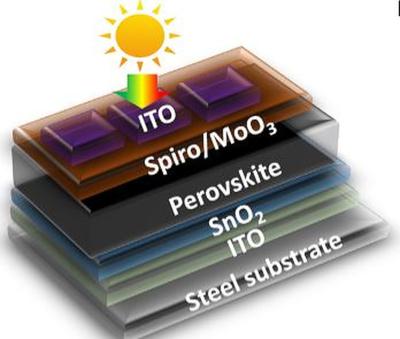Researchers from The University of Sydney, University of New South Wales, Macquarie University and University of Technology Sydney have demonstrated efficient perovskite solar cells (PSCs) on steel substrates.
The team explained that steel, being flexible and conductive, can itself can act as both a substrate and an electrode for either large-area-monolithic-panel or smaller-area-singular single-junction or multi-junction cell fabrication. The reported cells could be used for building-integrated PV (BIPV), vehicle-integrated solar (VIPV), or other design-integrated photovoltaics for terrestrial or space applications.
In the recent study, the researchers stressed that steel is not only flexible and conductive but also ofers good thermal stability, strength, and toughness. It is, however, an opaque material, which makes it necessary to use a transparent electrode for the solar cell. To this end, the scientists used an indium tin oxide (ITO) interlayer between the steel substrate and the cell, in order to avoid iron diffusion from the substrate into the PV device.
They built the cell with the steel substrate, an 80-nm-thick ITO layer, a tin(IV) oxide (SnO2) electron transport layer, the perovskite absorber, a Spiro-OMeTAD hole-transporting layer, a buffer layer made of molybdenum trioxide (MoO3), and the ITO transparent electrode.
A first device constructed with this configuration achieved a power conversion efficiency of 13.2%, an open-circuit voltage of 1,072 mV, a short-circuit current density of 18.3 mA/cm2, and a fill factor of 0.67. A similar cell built without the ITO interlayer, by contrast, achieved an efficiency of only 6%, with the other values being 763 mV, 17.2 mA/cm2, and 0.46, respectively.
The scientists decided to utilize a passivation strategy using a bromide-containing long alkyl chain organic cation n-OABra to further improve the performance of the cell using the ITO interlayer, which resulted in an enhanced efficiency of 17.1%, which they claim is the highest efficiency ever reported to date for a perovskite solar cell built on a steel substrate.
The team believes that this work could be the starting point for future work where different materials as an interlayer could be investigated and where cells using materials with better refractive index matching can be demonstrated with the aim of further boosting the performance and stability of perovskite cells on steel.




